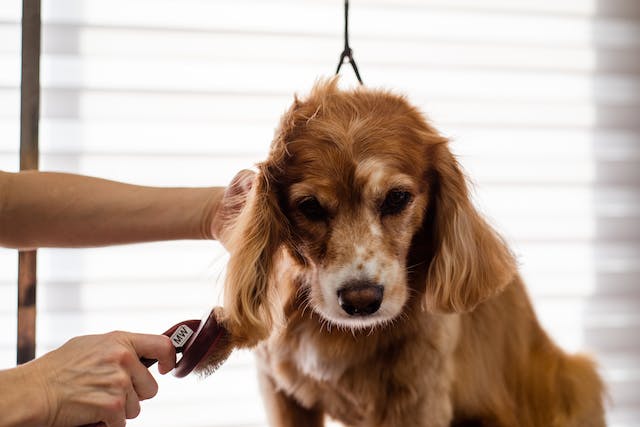Anxiety In Dogs [Causes, Signs, & Remedies]
![Anxiety In Dogs [Causes, Signs, & Remedies] Anxiety In Dogs](https://petcreeks.com/wp-content/uploads/2023/12/simon-hurry-_LhjpmruUAo-unsplash.jpg)
Today, let’s delve into a topic that’s close to the heart of all dog owners: anxiety in dogs.
If you’ve ever seen your furry friend pacing, trembling, or showing signs of distress, you know how heartbreaking it can be.
In this article, we’ll explore the common causes of anxiety in dogs and share some practical tips to help your pup find their inner calm.
So, please grab a cup of tea, and let’s dig in!
What is Anxiety In Dogs
Anxiety in dogs refers to a state of heightened fear, stress, or unease, it can manifest in various ways, such as excessive barking, destructive behavior, pacing, trembling, or withdrawal.
Common triggers include separation from their owners, loud noises, unfamiliar environments, or traumatic experiences.
Treatment options for canine anxiety may include behavior modification techniques, environmental management, pheromone therapy, and in some cases, medication prescribed by a veterinarian.
Let’s break it down further…
Signs of Anxiety In Dogs
![Anxiety In Dogs [Causes, Signs, & Remedies] Signs of Anxiety In Dogs](https://petcreeks.com/wp-content/uploads/2023/12/pexels-tanya-gorelova-3860310.jpg)
From my personal experience living with dogs, let me share some of the most common signs of anxiety in dogs.
The following are some common signs of anxiety in dogs:
Excessive Barking or Whining
When our dogs are feeling anxious, they may resort to excessive barking or whining as a way to vocalize their distress.
You might notice them barking more frequently than usual, especially in response to unfamiliar or stressful situations.
Similarly, persistent whining can be a clear signal that your dog is feeling anxious and seeking reassurance.
Panting and Pacing
Excessive panting and pacing can be telltale signs of anxiety in dogs.
Even in the absence of physical exertion or hot weather, if your dog is panting heavily and seemingly unable to settle down, it could be a sign of underlying anxiety.
Additionally, pacing back and forth in a repetitive manner, especially in response to certain triggers, can indicate heightened stress levels.
Destructive Behavior
Anxiety in dogs can lead to destructive behaviors, such as chewing on household items or digging at furniture.
This behavior is often a coping mechanism for their anxiety, and it can result in damage to your belongings.
If you notice uncharacteristic destruction, it’s worth considering whether anxiety might be the underlying cause.
Restlessness
Anxious dogs may struggle to relax and settle down, even in familiar surroundings.
They might appear fidgety, unable to find a comfortable position, and may frequently change locations in an attempt to find a sense of security.
This restlessness can be a clear indicator of their inner turmoil.
Aggression
While anxiety in dogs is often associated with fearfulness, it can also manifest as aggression.
Dogs may become more reactive or defensive when they’re feeling anxious, especially in situations that trigger their stress.
It’s important to approach this behavior with understanding and seek professional guidance to address the root cause.
Changes in Body Language
Keep an eye out for subtle changes in your dog’s body language. A tucked tail, ears pinned back, or avoiding eye contact can all be signs of anxiety.
These physical cues can provide valuable insights into your dog’s emotional state and help you offer the support they need.
Excessive Licking or Chewing
Dogs may resort to excessive licking or chewing on themselves, particularly their paws, when they’re feeling anxious.
This self-soothing behavior can lead to skin irritation and other health issues, so it’s crucial to address the underlying anxiety to prevent these negative outcomes.
Learn more about the signs of anxiety in dogs.
Causes of Anxiety In Dogs
![Anxiety In Dogs [Causes, Signs, & Remedies] Causes of Anxiety In Dogs](https://petcreeks.com/wp-content/uploads/2023/12/pexels-brandon-richardson-9468979.jpg)
Let’s discuss the most common causes of anxiety in dogs…
As a long-time owner of more than two dogs, here are some of the most common causes of anxiety in dogs from my experience:
Separation Anxiety
When it comes to separation anxiety, it’s important to recognize the signs, such as excessive barking, destructive behavior and attempts to escape.
Understanding that your dog may experience distress when left alone can help you take proactive steps to ease their anxiety, such as gradually acclimating them to alone time and providing engaging toys or treats.
Changes in Environment
Dogs can be sensitive to changes in their surroundings, whether it’s a move to a new home, exposure to loud noises, or encounters with unfamiliar people or animals.
Being mindful of these transitions and providing reassurance and familiar items can help dogs adjust and feel more secure in their new environment.
Lack of Socialization
Early socialization is crucial for a dog’s emotional well-being. If a dog lacks exposure to other dogs, animals, or people during their developmental stages, it may exhibit anxiety when faced with new social situations.
Encouraging positive interactions and experiences with others can help build a dog’s confidence and reduce anxiety.
Traumatic Experiences
Dogs that have experienced trauma, such as abuse, neglect, or frightening events, may exhibit anxiety-related behaviors.
It’s important for pet owners to provide a safe and nurturing environment, and in cases of severe trauma, seeking professional help from a veterinarian or animal behaviorist may be necessary.
Health Issues
Keeping an eye out for signs of health issues in dogs is crucial, as certain conditions, such as chronic pain, hormonal imbalances, or neurological disorders, can contribute to anxiety.
Regular veterinary check-ups and prompt attention to any health concerns can help alleviate anxiety caused by underlying medical conditions.
Aging and Cognitive Decline
As dogs age, they may experience cognitive decline, leading to anxiety and confusion.
Recognizing the signs of cognitive dysfunction syndrome (CDS) in senior dogs, such as disorientation and changes in behavior, can prompt pet owners to provide additional support and accommodations to help their aging companions feel more secure.
Loud Noises
Dogs have sensitive hearing, so loud noises such as fireworks, thunderstorms, or construction sounds can be overwhelming for them.
These sudden and unpredictable noises can cause anxiety or even panic attacks in some dogs.
Genetic Predisposition
Some dog breeds are known to be more sensitive or prone to anxiety due to genetic factors.
Understanding the tendencies of specific breeds can help pet owners anticipate and address anxiety-related behaviors, and providing a supportive environment tailored to their breed’s needs can make a significant difference.
By recognizing these common causes of anxiety in dogs and taking proactive steps to address them, pet owners can play a vital role in promoting their dog’s emotional well-being and ensuring they lead fulfilling lives as cherished members of the family.
Learn more about the common causes of anxiety in dogs.
How to Relieve Anxiety in Dogs
![Anxiety In Dogs [Causes, Signs, & Remedies] Relieving anxiety in dogs](https://petcreeks.com/wp-content/uploads/2023/12/r-r-medicinals-hn_wJh3Ex2A-unsplash.jpg)
From what we have discussed about anxiety in dogs, let’s not find out ways of helping a dog with anxiety.
Here are some common ways of how to help relieve anxiety in dogs:
1. Create a Safe and Comfortable Space for Your Dog
Creating a safe and comfortable space for your dog involves identifying a quiet, secure area where your dog can retreat to when they feel anxious.
It could be a cozy corner with their favorite blanket, a comfortable bed, or even a crate if your dog feels secure in one.
This space should be free from loud noises and distractions, allowing your dog to relax and feel safe.
2. Stick to a Consistent Routine
Sticking to a consistent routine is essential for reducing anxiety in dogs.
Dogs thrive on predictability, so maintaining regular feeding times, walking schedules, and playtime routines can provide a sense of security and stability for your furry friend.
Consistency helps reduce uncertainty and can have a calming effect on your dog.
3. Spend More Time Playing And Exercising Your Dog
Spending quality time playing and exercising with your dog is a fantastic way to alleviate anxiety.
Engaging in physical activities such as playing fetch, going for walks, or using interactive toys not only helps your dog burn off excess energy but also promotes mental stimulation and emotional well-being.
4. Provide Calming Music or White Noise
Playing calming music or white noise can create a soothing environment for your dog.
It helps mask loud noises from the environment and can have a relaxing effect on your pet.
There are specially designed music tracks and soundscapes that have been shown to reduce stress and anxiety in dogs.
5. Use of Pheromones
The use of pheromones, such as Adaptil, can help alleviate anxiety in dogs.
These synthetic pheromones mimic the natural calming pheromones produced by nursing mother dogs and can be used in various forms, including diffusers, sprays, and collars.
Pheromones can promote a sense of security and comfort in your dog.
6. Provide a Thundershirt or Anxiety Wrap
Thundershirts or anxiety wraps are designed to provide gentle, constant pressure to your dog’s body, similar to the comforting sensation of a hug.
This pressure has been shown to have a calming effect on dogs and can help reduce anxiety in stressful situations, such as during thunderstorms or fireworks.
7. Provide Behavior Training
Behavior training, including positive reinforcement and desensitization techniques, can help build your dog’s confidence and reduce anxiety.
Working with a professional dog trainer or behaviorist can provide guidance on addressing specific anxiety triggers and developing effective training strategies to promote positive behaviors.
8. Provide Gentle Massage and Physical Contact
Offering your dog gentle massages and physical contact can be incredibly soothing.
Petting, cuddling, and providing gentle massages can help reduce stress and anxiety in your dog while strengthening the bond between you and your pet.
9. Provide Herbal Remedies
For pet owners open to natural remedies, herbal options such as chamomile or valerian root may be considered for their potential calming effects.
It’s crucial to consult with a veterinarian before introducing any herbal remedies to ensure they are safe and appropriate for your dog.
10. Seek Professional Help
If your dog’s anxiety persists or becomes severe, seeking professional help from a veterinarian or certified dog behaviorist is crucial.
These professionals can assess your dog’s specific needs, identify the root causes of anxiety, and develop a tailored treatment plan to address the issue effectively.
By implementing these strategies and customizing them to your dog’s individual needs, you can create a supportive and calming environment that helps alleviate anxiety and promotes your dog’s overall well-being.
Learn more about how to relieve anxiety in dogs.
Conclusion
In conclusion, anxiety in dogs is a real and serious issue that deserves our attention and understanding. By recognizing the signs, seeking professional help, and providing a safe and nurturing environment, we can make a significant difference in our furry friends’ lives. Remember, a little empathy and compassion can go a long way in helping our anxious canine companions lead happier and healthier lives.






